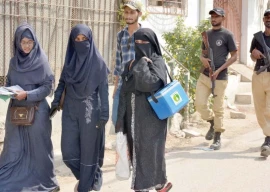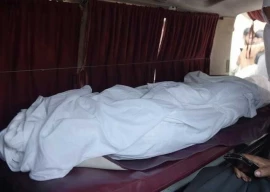
Living a luxurious life with your son, daughter-in-law and two granddaughters in a bungalow facing the sea is the perfect picture of a cereal packet happy family.
However, Farzana Shoaib needed something else for her contentment. She changed the dimensions of the family by turning her perfect little home into a shelter for old women in need. As many as 35 women over the age of 60 live in 10 rooms of her house.
According to Shoaib, the sole purpose of setting up the facility was to take care of and give platonic love to the old mothers. She believes in taking care of them herself instead of relying on maids and caretakers. “Caretakers and maids never serve them the way we do,” she reasoned. “They will do their 12-hour shift and leave. [In contrast], we are here 24 hours to keep an eye on them and help them.”

She recalled how last month, a woman named Kausar had trouble breathing at midnight. “My son took her to the hospital immediately,” she said, explaining how her son, Asad, is always there for the women. “Servants will never do this.”
Shoaib has the support of her family members who live with these 35 women like family. “At first, I was reluctant and didn’t support my mother as I felt this is a job for old age homes and shelter homes,” said Asad, recalling his initial stance in 2007 when the facility started. “But [then I realised that] the satisfaction you get from serving these ladies is something inexplicable.”
How the operations started
Shoaib and her son took care of seven women from their neighbourhood for almost five years. They then registered themselves in 2011 under the name, ‘Binte Fatima Old Home/Shelter’.
“Since the registration, we started getting many cases in which children living abroad left their mothers here alone,” said Shoaib. “Whenever people come to leave their mothers for admission in our shelter house, we try to patch them up and [encourage them to] live together.” According to her, she is very selective in giving admissions to women. Moreover, admission is not granted to any female without reference or proper paperwork.
Shoaib’s elder son and his wife serve around eight women at their residence in Bara Kahu, Islamabad. That shelter is also known as Binte Fatima.

“I earn my living and help my mother in bearing all the expenses by importing birds from Bahrain and Europe to Karachi,” said Asad. “There are some people who send money to take care of their mothers.”
The division of labour
“Many other shelter homes such as Madadgar and Panah helped us initially to understand the schematics,” said Asad, explaining how he, a businessman in Dubai before 2011, manages the affairs of the shelter home.
Ammara Asad, Shoaib’s daughter-in-law, and Asma, her 18-year-old granddaughter, assist in serving the women day and night. From giving them medicines and combing their hair to ironing their clothes and serving them their favourite food, these three women help the women with almost everything.
Ammara takes care of the medicines and treatment. She also consults doctors for them when needed. “Most of them need medicines as they are Alzheimer’s patients and their memory is fading with age,” she said.
According to Asma, she feels happy serving the women. “I have been very close to my grandmother since childhood which is why I feel happy to do the work she does,” said Asma, “Many of the women here need a free and open environment to enjoy their lives and others only need a smile from their younger ones.”
The shelter is divided into two sections: around 17 women live on the ground floor — they just need care and attention — while the others live on the first floor of the house. They are mentally unwell and need extra medical care.
“This is like my own family,” said 74-year-old Nuzhat who has been living in the shelter for the past six years. “I feel Hajra [Asad’s two-year-old daughter] is my own granddaughter.”
According to Halima, she was referred to Binte Fatima by her friend when her landlord asked her to leave last year. “I was an orphan,” said Halima, who loves to read. “ I needed somewhere to live where someone can take care of me in old age.”
Taking care:
A typical day at Binte Fatima
Shoaib has designed a planned routine to take care of the women as a majority of them suffer from varying blood pressure and diabetes and need to follow a strict pattern for food and medicine consumption.
All the women wake up early for Fajr prayers and are served breakfast by 8am. After that, Ammara gives them their medicines and many go for a walk while others watch TV.
The women are then served lunch, offer Zohr prayers between 12 noon and 2pm and then take a nap. After their siesta, they get ready for tea which is served at 5pm. During tea time, the women share nostalgic moments, sharing stories about their childhood and young age. They also sing and spend time with little Hajra.
A kind heart Why Binte Fatima?
Fatima, a 73-year-old woman, was Shoaib’s neighbour when they lived in apartments at Teen Talwar, Clifton. Fatima, who had migrated with her mother from India, never got married and lived alone after her mother died. One evening in 2007, Fatima fell in her bathroom and fractured her hip bone. She had remained there unconscious for four days.
After four days, her neighbours got worried and called the police to check on the old woman. Luckily, she was alive but had broken her bone. She could not move which is why she could not ask for help.
Many neighbours suggested that Fatima be sent to Edhi or some other old home. However, Fatima begged and cried in front of everyone to not send her to an old home, saying that all she needed was a family, a caring hand and a loving environment.
Shoaib, who was very close to the old woman, took her to the PNS Shifa Hospital for surgery and took care of her until her recovery. Within a year, she started walking again with a rod inserted in her right leg after the surgery.
The shelter home was named after Fatima who inaugurated it in 2011. Unfortunately, she died in 2012.
Published in The Express Tribune, June 1st, 2015.

















COMMENTS
Comments are moderated and generally will be posted if they are on-topic and not abusive.
For more information, please see our Comments FAQ